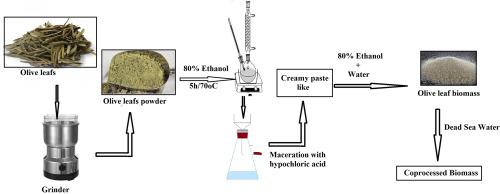Journal of Contaminant Hydrology ( IF 3.6 ) Pub Date : 2022-05-12 , DOI: 10.1016/j.jconhyd.2022.104025 Waseem Mahyoob 1 , Zuhier Alakayleh 2 , Husam A Abu Hajar 3 , Layaly Al-Mawla 1 , Abdelmnim M Altwaiq 4 , Mayyas Al-Remawi 1 , Faisal Al-Akayleh 1

|
Olive farming is one of the key agricultural activities in Jordan, where nearly 70% of the cultivated land in Jordan is covered with olive trees. Olive harvesting generates massive quantities of agricultural waste which will be an environmental burden if not managed properly. The present study introduces the use of novel co-processed biomass extracted from the olive tree leaves for the adsorption of lead from contaminated water. Several biomass co-processing techniques using different concentrations of sodium hydroxide, phosphoric acid, and the Dead Sea water were investigated and their effect on the removal efficiency was demonstrated. Moreover, the effect of several parameters on the adsorption efficiency including biomass particle size, solution pH, contact time, adsorbent amount, and lead ion concentration was explored. It was inferred that biomass co-processing enhanced the adsorption capacity of lead. It was also found that the adsorption efficiency increased with decreasing biomass particle size due to the increase in surface area. The highest lead removal was attained at an efficiency value of 70% for the 0.1 mm particle size and at a maximum adsorption capacity recorded at pH 5. The foregoing had a negatively charged biomass surface which, as such, favored the cationic adsorption (pHPZC values around 2.8–4.5). For lead biosorption, the process was a rapid process whereby most adsorption was observed within the first 20 min. Concurrently, there were no considerable changes in lead removal thereafter. Theoretically, this was attributed to the decrease in the available adsorption sites on the biomass surface. On the other hand, a continuous increase in the removal efficiency was recorded upon increasing the adsorbent amount. However, there was a continuous decline in the removal efficiency upon an increase in the initial lead concentration. The experimental data were fitted well with Langmuir isotherm (indicating a monolayer adsorption isotherm), while kinetic data showed the best fit with a pseudo-second-order kinetic model.
中文翻译:

一种新型的协同处理橄榄树叶生物质可用于从受污染的水中吸附铅
橄榄种植是约旦的主要农业活动之一,约旦近 70% 的耕地种植着橄榄树。橄榄收获会产生大量农业废物,如果管理不当,将成为环境负担。本研究介绍了使用从橄榄树叶中提取的新型协同处理生物质来吸附污染水中的铅。几种使用不同浓度氢氧化钠、磷酸的生物质协同处理技术, 并研究了死海水并证明了它们对去除效率的影响。此外,还探讨了几个参数对吸附效率的影响,包括生物质粒径、溶液 pH 值、接触时间、吸附剂用量和铅离子浓度。推测生物质协同处理增强了铅的吸附能力。还发现由于表面积的增加,吸附效率随着生物质颗粒尺寸的减小而增加。对于 0.1 mm 粒径,在 70% 的效率值和在 pH 5 记录的最大吸附容量下,达到最高的铅去除率。上述物质具有带负电荷的生物质表面,因此有利于阳离子吸附(pH PZC值在 2.8–4.5 左右)。对于铅的生物吸附,该过程是一个快速的过程,在最初的 20 分钟内观察到大部分吸附。同时,此后的铅去除没有显着变化。从理论上讲,这归因于生物质表面上可用吸附位点的减少。另一方面,随着吸附量的增加,去除效率持续增加。然而,随着初始铅浓度的增加,去除效率持续下降。实验数据与 Langmuir 等温线(表明单层吸附等温线)拟合良好,而动力学数据显示与准二级动力学模型的最佳拟合。



























 京公网安备 11010802027423号
京公网安备 11010802027423号